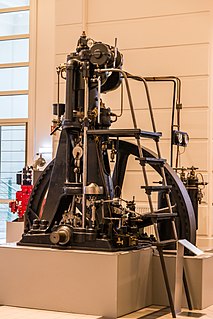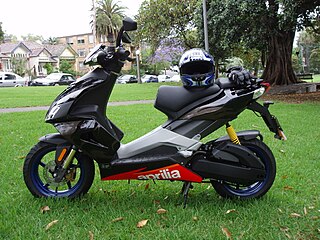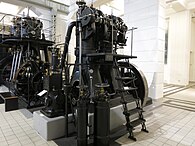
The diesel engine, named after Rudolf Diesel, is an internal combustion engine in which ignition of the fuel is caused by the elevated temperature of the air in the cylinder due to mechanical compression; thus, the diesel engine is a so-called compression-ignition engine. This contrasts with engines using spark plug-ignition of the air-fuel mixture, such as a petrol engine or a gas engine.

Fuel injection is the introduction of fuel in an internal combustion engine, most commonly automotive engines, by the means of an injector. This article focuses on fuel injection in reciprocating piston and rotary piston engines.
A stratified charge engine describes a certain type of internal combustion engine, usually spark ignition (SI) engine that can be used in trucks, automobiles, portable and stationary equipment. The term "stratified charge" refers to the working fluids and fuel vapors entering the cylinder. Usually the fuel is injected into the cylinder or enters as a fuel rich vapor where a spark or other means are used to initiate ignition where the fuel rich zone interacts with the air to promote complete combustion. A stratified charge can allow for slightly higher compression ratios without "knock," and leaner air/fuel ratio than in conventional internal combustion engines.

The Brayton cycle is a thermodynamic cycle that describes the operation of certain heat engines that have air or some other gas as their working fluid. The original Brayton engines used a piston compressor and piston expander, but modern gas turbine engines and airbreathing jet engines also follow the Brayton cycle. Although the cycle is usually run as an open system, it is conventionally assumed for the purposes of thermodynamic analysis that the exhaust gases are reused in the intake, enabling analysis as a closed system.
A combustion chamber is part of an internal combustion engine in which the fuel/air mix is burned. For steam engines, the term has also been used for an extension of the firebox which is used to allow a more complete combustion process.
Indirect injection in an internal combustion engine is fuel injection where fuel is not directly injected into the combustion chamber. Gasoline engines equipped with indirect injection systems, wherein a fuel injector delivers the fuel at some point before the intake valve, have mostly fallen out of favor to direct injection. However, certain manufacturers such as Volkswagen, Toyota and Ford have developed a 'dual injection' system, combining direct injectors with port (indirect) injectors, combining the benefits of both types of fuel injection. Direct injection allows the fuel to be precisely metered into the combustion chamber under high pressure which can lead to greater power, fuel efficiency. The issue with direct injection is that it typically leads to greater amounts of particulate matter and with the fuel no longer contacting the intake valves, carbon can accumulate on the intake valves over time. Adding indirect injection keeps fuel spraying on the intake valves, reducing or eliminating the carbon accumulation on intake valves and in low load conditions, indirect injection allows for better fuel-air mixing. This system is mainly used in higher cost models due to the added expense and complexity.

Gasoline direct injection (GDI), also known as petrol direct injection (PDI), is a mixture formation system for internal combustion engines that run on gasoline (petrol), where fuel is injected into the combustion chamber. This is distinct from manifold fuel injection systems, which inject fuel into the intake manifold.

The hot-bulb engine is a type of internal combustion engine in which fuel ignites by coming in contact with a red-hot metal surface inside a bulb, followed by the introduction of air (oxygen) compressed into the hot-bulb chamber by the rising piston. There is some ignition when the fuel is introduced, but it quickly uses up the available oxygen in the bulb. Vigorous ignition takes place only when sufficient oxygen is supplied to the hot-bulb chamber on the compression stroke of the engine.

The Aprilia SR50 is a scooter built by Aprilia. Introduced in 1992, more than 800,000 units have been sold, bucking the trend for less use of two-stroke engines. Aprilia claims several firsts for the SR50 in the scooter market, including 13 inch wheels, liquid cooling, double disc braking, and a direct injection engine.

A glowplug is a heating device used to aid in starting diesel engines. In cold weather, high-speed diesel engines can be difficult to start because the mass of the cylinder block and cylinder head absorb the heat of compression, preventing ignition. Pre-chambered engines use small glowplugs inside the pre-chambers. Direct-injected engines have these glowplugs in the combustion chamber.
Diesel engine runaway is a rare condition affecting diesel engines, in which the engine draws extra fuel from an unintended source and overspeeds at higher and higher RPM, producing up to ten times the engine's rated output until destroyed by mechanical failure or bearing seizure due to a lack of lubrication. Two-stroke hot-bulb engines can also run away via the same process.

A two-stroke diesel engine is an internal combustion engine that uses compression ignition, with a two-stroke combustion cycle. It was invented by Hugo Güldner in 1899.
Internal combustion engines come in a wide variety of types, but have certain family resemblances, and thus share many common types of components.

An internal combustion engine is a heat engine in which the combustion of a fuel occurs with an oxidizer in a combustion chamber that is an integral part of the working fluid flow circuit. In an internal combustion engine, the expansion of the high-temperature and high-pressure gases produced by combustion applies direct force to some component of the engine. The force is applied typically to pistons, turbine blades, a rotor, or a nozzle. This force moves the component over a distance, transforming chemical energy into useful kinetic energy and is used to propel, move or power whatever the engine is attached to. This replaced the external combustion engine for applications where weight or size of the engine is important.

The Mercedes-Benz OM 138 is a diesel engine manufactured by Daimler-Benz. In total, 5,719 units were produced between 1935 and 1940. It was the first diesel engine especially developed and made for a passenger car. The first vehicle powered by the OM 138 was the Mercedes-Benz W 138. The light Mercedes-Benz trucks L 1100 and L 1500 as well as the bus O 1500 were also offered with the OM 138 as an alternative to the standard Otto engine.
Julius Magg was an Austrian engineer and university professor. In the early 20th century, he contributed significantly to the further development of the Diesel engine. Later, he was known as the founder of the Graz method of engine design.

The MAN M-System, also referred to as M-Process and M combustion process, is a direct injection system for Diesel engines. In M-System engines, the fuel is injected onto the walls of the combustion chamber that is solely located inside the piston, and shaped like a sphere. The M-System was rendered obsolete by modern fuel injection systems for Diesel engines. Due to its particularities, the M-System was only used for stationary applications and commercial vehicle engines, passenger car engines with this design have never been made. The letter M is an abbreviation for the German word Mittenkugelverfahren, meaning centre sphere combustion process.
Manifold injection is a mixture formation system for internal combustion engines with external mixture formation. It is commonly used in engines with spark ignition that use petrol as fuel, such as the Otto engine, and the Wankel engine. In a manifold-injected engine, the fuel is injected into the intake manifold, where it begins forming a combustible air-fuel mixture with the air. As soon as the intake valve opens, the piston starts sucking in the still forming mixture. Usually, this mixture is relatively homogeneous, and, at least in production engines for passenger cars, approximately stoichiometric; this means that there is an even distribution of fuel and air across the combustion chamber, and enough, but not more air present than what is required for the fuel's complete combustion. The injection timing and measuring of the fuel amount can be controlled either mechanically, or electronically. Since the 1970s and 1980s, manifold injection has been replacing carburettors in passenger cars. However, since the late 1990s, car manufacturers have started using petrol direct injection, which caused a decline in manifold injection installation in newly produced cars.

The Motor 250/400 is the first functional diesel engine. It was designed by Rudolf Diesel, and drawn by Imanuel Lauster. The workshop of the Maschinenfabrik Augsburg built two units, the A-Motor, and the B-Motor. The latter has been on static display at the Deutsches Museum in Munich since testing it came to an end. Throughout the late 1890s, several licensed copies of the Motor 250/400 were made. Most of these copies were very unreliable, which almost caused the diesel engine's demise.
Friedrich Sass was a German engineer, university professor and historian.


















